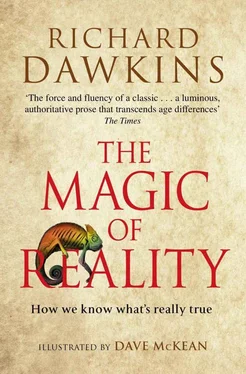Most of the area of most of the plates lies under the sea. The land masses we know as the continents are the high ground of the plates, sticking up above the water. Africa is just the top of the much larger African plate, which stretches halfway across the South Atlantic. South America is the top of the South American plate, which stretches across the other half of the South Atlantic. Other plates are the Indian and Australian plates; the Eurasian plate, which consists of Europe and all of Asia except India; the Arabian plate, which is rather small and slots in between the Eurasian plate and the African plate; and the North American plate, which includes Greenland as well as North America and reaches halfway across the bottom of the North Atlantic ocean. And there are some plates that have hardly any dry land on them at all, for example the vast Pacific plate.
The divide between the South American plate and the African plate runs right down the middle of the South Atlantic, miles from either continent. Remember that the plates include the bottom of the sea, and that means hard rock. So how could South America and Africa have nestled together 150 million years ago? Wegener would have had no problem here, because he thought the continents themselves drifted about. But if South America and Africa once snuggled together, how does plate tectonics explain all the undersea hard rock that nowadays separates them? Have the undersea parts of the rocky plates somehow managed to grow?
Yes. The answer lies in something called ‘sea-floor spreading’. You know those moving walkways that you see at large airports to help people with luggage cover the long distances between, say, the entrance to the terminal and the departure lounge? Instead of having to walk all the way, they step on a moving belt and are carried along to some point where they have to start walking again. The moving walkway at an airport is only just wide enough for two people to stand side by side. But now imagine a moving walkway that is thousands of miles wide, stretching most of the way from the Arctic to the Antarctic. And imagine that, instead of moving at walking pace, it moves at the speed with which fingernails grow. Yes, you’ve guessed it. South America, and the whole South American plate, is being carried away from Africa and the African plate, on something like a moving walkway that lies deep under the sea bed and stretches from the far north to the far south of the Atlantic Ocean, moving very slowly.
What about Africa? Why isn’t the African plate moving in the same direction, and why doesn’t it keep up with the South American plate?
The answer is that Africa is on a different moving walkway, one that is travelling in the opposite direction. The African moving walkway goes from west to east, while the South American moving walkway goes from east to west. So what is going on in the middle? Next time you are at a big airport, stop just before you step on the moving walkway and watch it. It wells up out of a slit in the floor, and moves away from you. It is a belt, going round and round, travelling forwards above the floor and coming back towards you under the floor. Now imagine another belt, welling out of the same slit but going in exactly the opposite direction. If you put one foot on one belt and the other foot on the other belt you’d be forced to do the splits.
The equivalent of the slit in the floor at the bottom of the Atlantic Ocean runs all along the deep sea floor from the far south to the far north. It is called the mid-Atlantic ridge. The two ‘belts’ well up through the mid-Atlantic ridge and head off in opposite directions, one carrying South America steadily westwards, the other carrying Africa away to the east. And, like the belts at the airport, the great belts that move the tectonic plates roll around and come back deep within the Earth.
Next time you are at an airport, get on the moving walkway and let it carry you, while you imagine you are Africa (or South America if you prefer). When you get to the other end of the walkway and step off, watch the belt dive underground, ready to make its way back to where you’ve just come from.
The moving belts at an airport are driven by electric motors. What drives the moving belts that carry the great plates of the Earth with their cargo of continents? Deep beneath the Earth’s surface there are what are called convection currents. What’s a convection current? Maybe you have an electric convector heater in your house. Here’s how it works to heat a room. It heats air. Hot air rises because it is less dense than cold air (that’s how hot-air balloons work). The hot air rises until it hits the ceiling, where it can’t rise any more and is forced sideways by the fresh hot air pushing up from beneath. As it travels sideways, the air cools down, whereupon it sinks. When it hits the floor, it again moves sideways, creeping along the floor until it gets caught up in the heater and rises again. That explanation is a bit too simple, but the basic idea is all that matters here: under ideal conditions a convector heater can get the air moving round and round – circulating. This kind of circulation is called a ‘convection current’.
The same thing happens in water. In fact, it can happen in any liquid or any gas. But how can there be convection currents under the Earth’s surface? It isn’t liquid down there, is it? Well, yes, it is – sort of. Not liquid like water, but sort of half liquid like thick honey or treacle. That’s because it is so hot that everything is melting. The heat comes from deep down. The centre of the Earth is very hot indeed, and it goes on being hot until much closer to the surface. Occasionally the heat bursts out through the surface at a place we call a volcano.
The plates are made of hard rock, and, as we’ve seen, most of them is under the sea. Each plate is several miles thick. This thick layer of armour plating is called the lithosphere, which literally means ‘sphere of rock’. Under the sphere of rock is an even thicker layer, if you can believe it, which isn’t actually called the sphere of treacle but probably should be (it’s actually the upper mantle). The hard rocky plates of the sphere of rock could be said to ‘float’ on the sphere of treacle. Deep heat beneath and within the sphere of treacle causes agonizingly slow, grinding convection currents in the treacle, and it is those convection currents that carry the great rocky plates floating above.
Convection currents follow pretty complicated paths. Just think about all the different ocean currents, and even the winds, which are sort of high-speed convection currents. So it’s no wonder that the various plates on the Earth’s surface are carried in all sorts of directions, rather than round and round as if they were all on a simple merry-go-round. No wonder the plates bump into each other or tear rendingly away from each other, dive one under the other or grate sideways against each other. And no wonder we feel these titanic forces – grinding, wrenching, roaring, scraping forces – as earthquakes. Terrible as earthquakes can be, the wonder is that they aren’t even more terrible.
Sometimes a moving plate slides underneath a neighbouring plate. This is called ‘subduction’. Part of the African plate, for example, is being subducted under the Eurasian plate. This is one reason why there are earthquakes in Italy, and it is one reason why Mount Vesuvius erupted in ancient Roman times and destroyed the towns of Pompeii and Herculaneum (because volcanoes tend to sprout along the edges of the plates). The Himalayan mountains, including Mount Everest, were forced up to their great height as the Indian plate was steadily subducted under the Eurasian plate.
Читать дальше











